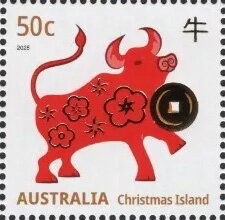Stamp: Cattle (Christmas Island 2025)
Cattle (Christmas Island 2025)
07 January (Christmas Island ) within release Year of the Snake 2025 goes into circulation Stamp Cattle face value 50 Australian cent
| Stamp Cattle in catalogues | |
|---|---|
| Colnect codes: | Col: CX 2025.01.07-06d |
Stamp is square format.
Stamp from rectangular Mini Sheet with ordinary gum.Also in the issue Year of the Snake 2025:
- Stamp - Cattle face value 50;
- Stamp - Cattle face value 50;
- Stamp - Dog face value 1;
- Stamp - Dog face value 1;
- Stamp - Dragon face value 1;
- Stamp - Dragon face value 1;
- Stamp - Goat face value 1.20;
- Stamp - Goat face value 1.20;
- Stamp - Horse face value 50;
- Stamp - Horse face value 50;
- Stamp - Monkey face value 50;
- Stamp - Monkey face value 50;
- Stamp - Pig face value 30;
- Stamp - Pig face value 30;
- Stamp - Rabbit face value 1;
- Stamp - Rabbit face value 1;
- Stamp - Rat face value 1.20;
- Stamp - Rat face value 1.20;
- Stamp - Rooster face value 1.20;
- Stamp - Rooster face value 1.20;
- Stamp - Snake face value 30;
- Stamp - Snake face value 30;
- Stamp - Tiger face value 30;
- Stamp - Tiger face value 30;
- Stamp - Year of the Snake 2025 face value 1.50;
- Stamp - Year of the Snake 2025 face value 3;
- Stamp - Year of the Snake 2025 face value 3.30;
- Stamp - Year of the Snake 2025 face value 3.30;
- Full Pane - Year of the Snake 2025 face value 5*3.30;
- Souvenir Sheet - Year of the Snake 2025 face value 7.80;
- Mini Sheet - Year of the Snake 2025 face value 16.80;
- Mini Sheet - Year of the Snake 2025 face value 17;
- Stamp - Year of the Snake 2025 face value 8;
- Gutter Pairs - Year of the Snake 2025 Gutter Strip face value 10*1.50;
Stamp Cattle it reflects the thematic directions:
Animals are multicellular, eukaryotic organisms of the kingdom Animalia (also called Metazoa). All animals are motile, meaning they can move spontaneously and independently, at some point in their lives. Their body plan eventually becomes fixed as they develop, although some undergo a process of metamorphosis later on in their lives. All animals are heterotrophs: they must ingest other organisms or their products for sustenance.
Cattle (Bos taurus) are large, domesticated, bovid ungulates widely kept as livestock. They are prominent modern members of the subfamily Bovinae and the most widespread species of the genus Bos. Mature female cattle are called cows and mature male cattle are bulls. Young female cattle are called heifers, young male cattle are oxen or bullocks, and castrated male cattle are known as steers.
Chinese New Year or the Spring Festival (see also § Names) is a festival that celebrates the beginning of a new year on the traditional lunisolar Chinese calendar. Marking the end of winter and the beginning of spring, observances traditionally take place from Chinese New Year's Eve, the evening preceding the first day of the year, to the Lantern Festival, held on the 15th day of the year. The first day of Chinese New Year begins on the new moon that appears between 21 January and 20 February
Mammals are any vertebrates within the class Mammalia (/məˈmeɪli.ə/ from Latin mamma "breast"), a clade of endothermic amniotes distinguished from reptiles (including birds) by the possession of a neocortex (a region of the brain), hair, three middle ear bones and mammary glands. All female mammals nurse their young with milk, secreted from the mammary glands. Mammals include the largest animals on the planet, the great whales. The basic body type is a terrestrial quadruped, but some mammals are adapted for life at sea, in the air, in trees, underground or on two legs. The largest group of mammals, the placentals, have a placenta, which enables the feeding of the fetus during gestation. Mammals range in size from the 30–40 mm (1.2–1.6 in) bumblebee bat to the 30-meter (98 ft) blue whale. With the exception of the five species of monotreme (egg-laying mammals), all modern mammals give birth to live young. Most mammals, including the six most species-rich orders, belong to the placental group. The largest orders are the rodents, bats and Soricomorpha (shrews and allies). The next three biggest orders, depending on the biological classification scheme used, are the Primates (apes and monkeys), the Cetartiodactyla (whales and even-toed ungulates), and the Carnivora (cats, dogs, seals, and allies).






